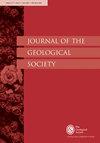比你想象的要古老:使用U-Pb方解石地质年代学更好地约束盆地边界断层的再活化,内马里湾盆地,北海西部
IF 3
3区 地球科学
Q2 GEOSCIENCES, MULTIDISCIPLINARY
引用次数: 2
摘要
与世界各地的许多裂谷盆地一样,内马里湾盆地(IMFB)以主要的重新激活断层带为界,包括Helmsdale和Great Glen断层(HF、GGF)。在Helmsdale和Shandwick断层附近的陆上暴露的侏罗纪序列分别保留了与左旋(HF)和右旋(GGF)张拉运动一致的褶皱、方解石脉和小断层。这种变形被广泛归因于新生代裂谷后断层的复活。陆上实地调查和五个脉样品的U-Pb方解石地质年代测定表明,断层作用发生在早白垩世(约128-115 Ma,Barremian Aptian),而HF保留了晚侏罗世早期左旋运动的证据(约159 Ma,Oxfordian)。这表明,在形成IMFB的幕式NW-SE定向中生代裂谷作用期间,两个盆地边界断层基本上都被重新激活了。虽然有很好的证据表明近海GGF新生代复活,但IMFB北海岸的这种变形程度仍不确定。我们的发现还说明了斜滑再激活过程在形成大陆裂谷盆地演化中的重要性,因为这种变形类型在海上地震反射数据的解释中可能并不明显。补充材料:https://doi.org/10.6084/m9.figshare.c.6708518本文章由计算机程序翻译,如有差异,请以英文原文为准。
Older than you think: Using U-Pb calcite geochronology to better constrain basin-bounding fault reactivation, Inner Moray Firth Basin, W North Sea
Like many rift basins worldwide, the Inner Moray Firth Basin (IMFB) is bounded by major reactivated fault zones including the Helmsdale and Great Glen faults (HF, GGF). The Jurassic successions exposed onshore close to these faults at Helmsdale and Shandwick preserve folding, calcite veining and minor faulting consistent with sinistral (HF) and dextral (GGF) transtensional movements, respectively. This deformation has widely been attributed to Cenozoic post-rift fault reactivation.
Onshore fieldwork and U-Pb calcite geochronology of five vein samples associated with transtensional movements along the HF and a splay of the GGF show that faulting occurred during the Early Cretaceous (c. 128-115 Ma, Barremian-Aptian), whilst the HF preserves evidence for earlier Late Jurassic sinistral movements (c. 159 Ma, Oxfordian). This demonstrates that both basin-bounding faults were substantially reactivated during the episodic NW-SE-directed Mesozoic rifting that formed the IMFB. Whilst there is good evidence for Cenozoic reactivation of the GGF offshore, the extent of such deformation along the north coast of the IMFB remains uncertain. Our findings also illustrate the importance of oblique slip reactivation processes in shaping the evolution of continental rift basins given that this deformation style may not be immediately obvious in interpretations of offshore seismic reflection data.
Supplementary material:
https://doi.org/10.6084/m9.figshare.c.6708518
求助全文
通过发布文献求助,成功后即可免费获取论文全文。
去求助
来源期刊

Journal of the Geological Society
地学-地球科学综合
CiteScore
6.00
自引率
3.70%
发文量
68
审稿时长
6-12 weeks
期刊介绍:
Journal of the Geological Society (JGS) is owned and published by the Geological Society of London.
JGS publishes topical, high-quality recent research across the full range of Earth Sciences. Papers are interdisciplinary in nature and emphasize the development of an understanding of fundamental geological processes. Broad interest articles that refer to regional studies, but which extend beyond their geographical context are also welcomed.
Each year JGS presents the ‘JGS Early Career Award'' for papers published in the journal, which rewards the writing of well-written, exciting papers from early career geologists.
The journal publishes research and invited review articles, discussion papers and thematic sets.
 求助内容:
求助内容: 应助结果提醒方式:
应助结果提醒方式:


